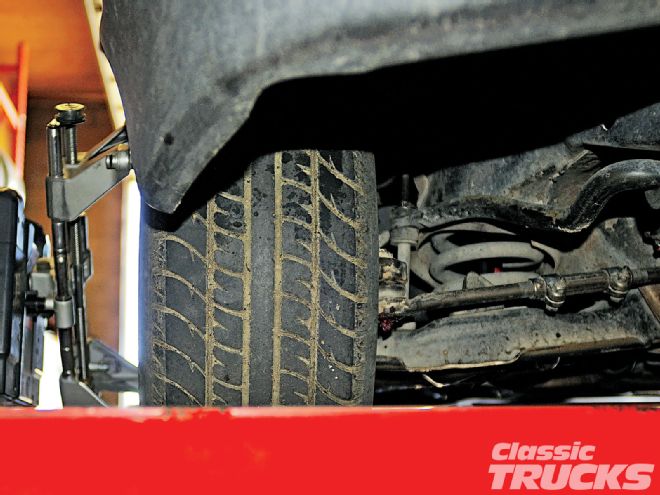
Wheel alignment affects safety, handling, and performance. Abnormal tire wear and handling quirks signal the need for wheel alignment. Modifying the chassis or suspension requires a trip to the alignment shop. Wheel alignment is routine service for trucks with a solid, hypoid rear axle and a beam, twin-beam, or independent front suspension (IFS) system.
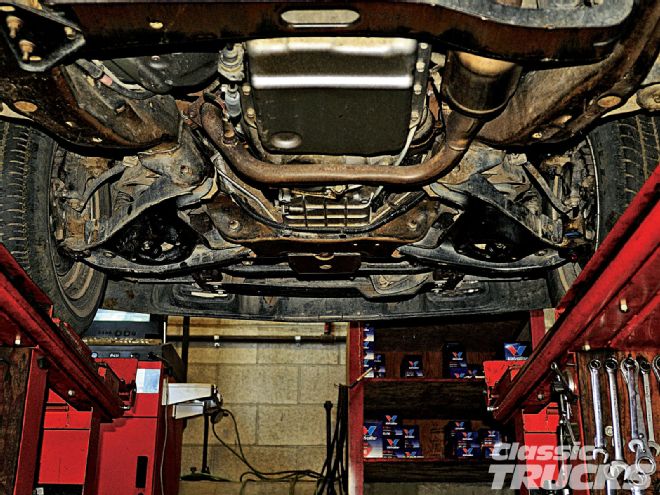 A modern alignment rack can check caster, camber, toe set, and steering axis inclination (SAI). Front tires float on sliding, rotating turn plates to unload suspension and allow free movement as the wheels turn. Although a solid rear axle truck does not require rear toe adjustment, the rear axle must be square with the frame's centerline.
A modern alignment rack can check caster, camber, toe set, and steering axis inclination (SAI). Front tires float on sliding, rotating turn plates to unload suspension and allow free movement as the wheels turn. Although a solid rear axle truck does not require rear toe adjustment, the rear axle must be square with the frame's centerline.
A vintage I-beam front axle has the simplest alignment needs. If the axle beam is true, the kingpins fit properly and springs do not sag, alignment may be as easy as setting the toe-in of the front wheels. For the truck with IFS, wheel alignment involves periodic checks and adjustment of caster, camber, and toe-in.
Alignment at a modern shop includes four-wheel "thrust" inspection, caster set, camber set, and toe set. Some shops can perform a true "four-wheel alignment," but unless a classic truck has a retrofit independent rear suspension (IRS) system, four-wheel alignment is not necessary.
Thrust alignment takes rear axle shift, worn springs and bushings, or a bent frame into account. A shop that performs either four-wheel or thrust alignment can handle any truck with a solid, hypoid rear axle system. To push the vehicle forward in a straight line, rear axle thrust must be perpendicular to the centerline of the frame. When thrust is correct, a front wheel alignment can assure precise steering and a normal steering wheel position.
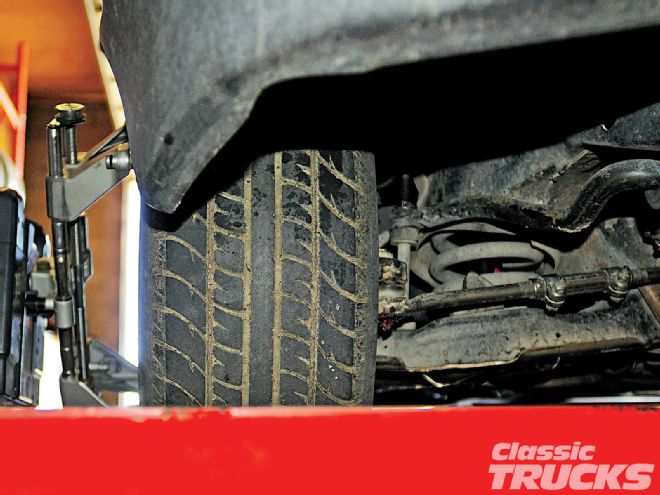 Checking wheel alignment begins with matched tires, even tread wear and proper tire inflation. A common problem is radial pull. Left or right radial tire pull is often confused with toe or caster error. If the tires have a non-directional tread, radial pull can sometimes be corrected by simply switching the front tires from side to side.
Checking wheel alignment begins with matched tires, even tread wear and proper tire inflation. A common problem is radial pull. Left or right radial tire pull is often confused with toe or caster error. If the tires have a non-directional tread, radial pull can sometimes be corrected by simply switching the front tires from side to side.
Toe Set
Toe-in is the angle that the front wheels point when the steering aims straight ahead. While parallel front wheels would seem ideal, the front wheels seldom call for 0 degrees of toe set. Due to the thrust loads of the vehicle moving forward and the nominal movement of steering joints under load, toe is actually set so that the tires "toe-in" slightly at the front. When turning, the inside wheel has a tighter turning angle than the outside wheel.
Tire design dictates toe-in requirements. Bias-ply tires have a tendency to thrust outward under load. The vintage truck with bias-ply tires should follow the factory alignment specifications. That toe-in might be in the 1/16- to 3/16-inch range, typically a 1/8-inch setting. If using modern radial tires, toe-in should be more like 1/32 inch, actually measured in tenths of a degree, not inches, using modern alignment equipment.
For the older truck with a beam front axle, toe-in may be the only adjustment needed. If the frame and axle beam are straight, the springs set evenly, the kingpins fit properly, and caster angle meets specification, it is possible to do your own toe set adjustments. A simple toe bar can be purchased through automotive tool suppliers.
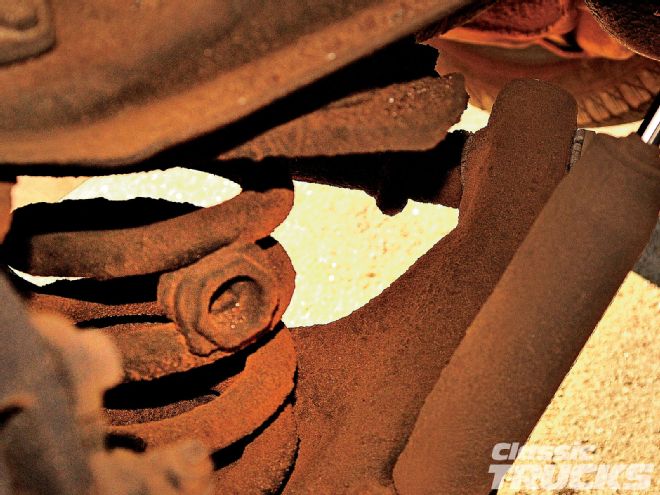 A budget spring spacer is one way to compensate for sagging or short coil springs. Such a device will distort the coil and may also creep or dislodge. The proper fix is new, matched coil springs of the correct length and spring rate. Cutting or spreading coil springs to adjust or level the ride height creates unsafe and erratic spring behavior.
A budget spring spacer is one way to compensate for sagging or short coil springs. Such a device will distort the coil and may also creep or dislodge. The proper fix is new, matched coil springs of the correct length and spring rate. Cutting or spreading coil springs to adjust or level the ride height creates unsafe and erratic spring behavior.
Point the front wheels straight ahead. On a flat floor, lift the front axle slightly to eliminate load thrust. Support the axle safely. Scribe a line at the centerline of each front tire tread. The toe bar gauge measures the distance between these centerlines, as close as possible to the midline (front and rear) of the tire. This kind of alignment serves well when there are no defects in the steering linkage, steering gear, kingpins, suspension, or wheel rims.
When caster and camber settings are known to be correct, the toe bar will also work on an IFS or twin-beam suspension. Support the front suspension with a floor jack under each lower control arm or the outer end of each I-beam. Lift the wheels evenly, just off the floor, and make sure the vehicle is safely supported before handling the wheels. Scribe the tread centerlines and set toe to specification with the suspension weighted.
Camber
With the chassis weighted and the front tires pointing straight ahead, each tire should stand nearly vertical. Viewed from the front of the vehicle, camber degrees are the tilt of the tire from a vertical centerline. If the top of the tire tilts outward, camber is positive. If the top of the tire tilts inward, camber is negative. Alignment specifications read in positive or negative degrees of camber.
Early beam-type axles with leaf springs have fixed camber. As the vehicle's frame and body lean on corners, the axle stays parallel with the ground. With this design, there is no provision to adjust the camber. Unless bent, the axle maintains its original camber setting.
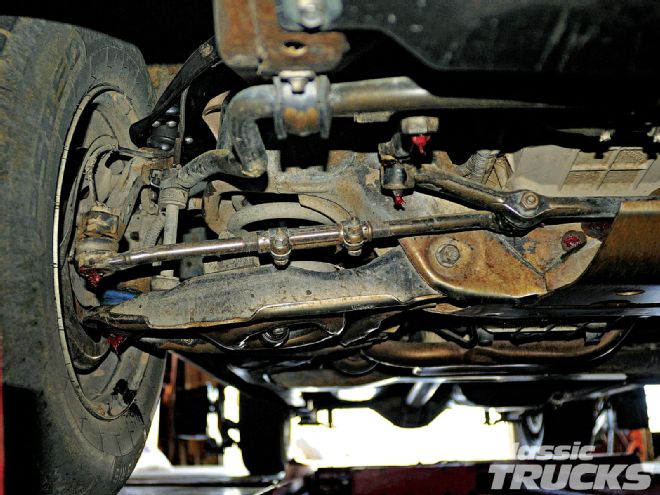 Grease and inspect all joints before performing an alignment. It is a waste of money to align a frontend with loose suspension or steering linkage. Note that the upper A-arm is new, with a riveted ball joint. This vehicle needed a new arm and cross-shaft. Original bushings wore out and damaged the A-arm. The repair includes a frontend alignment.
Grease and inspect all joints before performing an alignment. It is a waste of money to align a frontend with loose suspension or steering linkage. Note that the upper A-arm is new, with a riveted ball joint. This vehicle needed a new arm and cross-shaft. Original bushings wore out and damaged the A-arm. The repair includes a frontend alignment.
By contrast, each front wheel on an IFS or twin I-beam suspension moves up or down independently. Short (upper) and long (lower) control arm "SLA" suspension compensates for body/frame lean on corners. As the vehicle corners, the body/frame rolls, causing the outside wheels to compress the springs. This moves the wheels upward into the fenderwells. The unloading inside wheels drop as the body rolls outward. (Functioning sway bars help minimize this roll.) On SLA suspension, tire track width remains relatively constant during this process. The arc of wheel travel is precisely engineered for maximum control and longer tire life.
SLA suspension is a true independent design. Ford's twin I-beam has been called IFS because each beam moves independently. However, these two solid beams pivot from fixed points. This means that on turns, the outer wheel compresses the coil spring and moves in a fixed arc upward. The inner wheel drops as the body rolls outward. Optimally, these arcs should cancel each other, keeping tire track width reasonably constant.
Twin-beam suspension has a drawback. If the chassis rises upward while the truck is on a straight road (like a raised railroad crossing taken at speed), the beams drop in fixed arcs, with each wheel shifting to positive degrees of camber. This narrows the tire contact patches and track. (Simulate this by lifting a twin I-beam truck on a frame hoist. Watch the front wheel drop angles.) When the chassis settles, the beams must force the tires outward to near vertical camber. Under certain driving conditions, lateral scuffing increases tire wear.
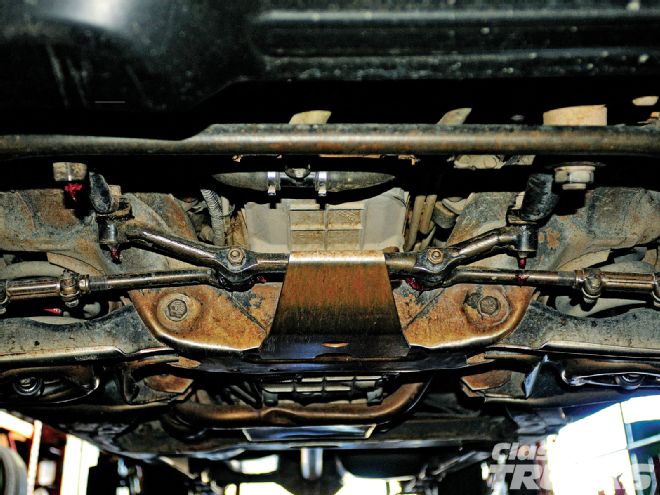 The center link connects the pitman arm and the idler arm. An idler arm keeps the center link moving on a uniform plane. Load on the idler arm makes this a common wear item. Check the tie-rod joints and idler arm bushings for wear and play. Push up and down on the center link, tie rods, and idler arm to feel movement.
The center link connects the pitman arm and the idler arm. An idler arm keeps the center link moving on a uniform plane. Load on the idler arm makes this a common wear item. Check the tie-rod joints and idler arm bushings for wear and play. Push up and down on the center link, tie rods, and idler arm to feel movement.
Twin I-beam is also sensitive to vehicle ride height. When installing a cab-over camper or a heavier V-8, the added weight requires frontend camber and toe-in adjustment. With SLA/IFS, wheel travel arcs have less effect on camber, and the steering toe is more controlled during suspension movement and changes in vehicle ride height.
Caster
Caster plays an important role in vehicle handling. Caster is the tilt of the kingpin or ball joint centerlines when viewed from the side. The forward or rearward tilt of this centerline, measured in degrees, is caster angle. Note that the kingpin or ball joint centerline tilts inward as well, but this is not caster. Inward tilt is kingpin inclination, a measurement that affects the steering axis inclination (SAI). When caster and camber are within specification, SAI should be as well. If not, suspect a bent or defective spindle/knuckle.
The typical front suspension calls for positive degrees of caster. Positive caster means that the upper end of the kingpin/ball joint centerline tilts toward the rear of the vehicle. Caster has a very important function: helping the wheels come back to center after turns. When there is no caster angle, the most notable symptom is the need to steer the vehicle back to center. Correct caster settings also help steer the vehicle straight ahead, despite the crown of the road. Caster angle helps prevent pull and reduces the risk of kingpin or ball joint shimmy.
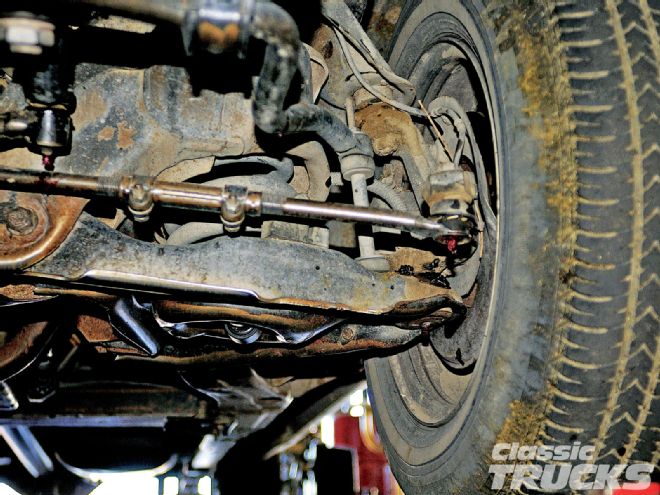 A bent spindle and knuckle assembly will show up as inaccurate SAI. SAI reflects caster and camber angles as the wheels and tires swing in an arc, left to right. If caster and camber are correct and the SAI is out of specification, look for a bent or defective spindle/knuckle. Loose upper or lower ball joints cause shimmy.
A bent spindle and knuckle assembly will show up as inaccurate SAI. SAI reflects caster and camber angles as the wheels and tires swing in an arc, left to right. If caster and camber are correct and the SAI is out of specification, look for a bent or defective spindle/knuckle. Loose upper or lower ball joints cause shimmy.
Whether setting up a modified suspension or simply restoring a classic truck's steering, take caster, camber, and toe-in into account. Changes in spring length, dropped spindle kits, and lowering a truck may alter these adjustments. For improved steering control, safe handling, and minimizing tire wear, wheel alignment plays a vital role.
What Did You Learn This Month?
Night School would not be complete without a quiz! Don't worry about your test-taking skills or grades. This is an open-magazine, true or false test. Clues can be found within the Night School text, photos, and captions. Have a good month!
True or False Questions:
1. Thrust misalignment could mean the rear axle has shifted. Worn springs, bad spring bushings, or a bent frame may also account for thrust problems.
2. If a vintage monobeam axle and frame are straight, the springs set evenly, the kingpins fit properly and caster angle meets specification, it is possible to set toe-in yourself.
3. Viewed from the front of the vehicle, camber degrees are the tilt of each front tire from a vertical centerline. If the top of the tire tilts inward, camber is "negative."
4. If a twin I-beam chassis rises straight up, the beams drop in fixed arcs. Each wheel shifts in positive degrees of camber, and the tire contact pattern at the road surface narrows.
5. Specs call for more right side caster angle than left. Extra caster compensates for road crown, enabling the vehicle to steer without pull on a straight, crowned roadway.
6. It is perfectly all right to align a frontend with worn bushings, loose steering linkage, worn knuckle ball joints, or damaged components. You'll save money.
7. With independent SLA front suspension, the toe-in can be adjusted separately for each wheel. This allows adjustment with the steering gear and steering wheel on center.
8. A common tire problem is radial pull. If the tires have a non-directional tread, radial pull can sometimes be corrected by simply switching the front tires from side to side.
9. If you cut the coil springs to lower your truck and a spring ends up too short, a twist-in spring spacer is a great way to compensate for sagging or short coil springs.
10. When caster and camber are on specification and SAI is out of specification, the spindle or steering knuckle could be damaged.
1 True, 2 True, 3 True, 4 True, 5 True, 6 False, 7 True, 8 True, 9 False, 10 True